Age should never come in the way of your love for gardening. If anything, practicing gardening in old age helps keep the body in good shape, stimulates the mind, and boosts mental health. Besides the benefits of physical work, being around plants and green spaces reduces stress and negative feelings and improves moods. But as the years take their toll on one’s back, hips, and knees, certain adjustments have to be made in how you garden and in the garden itself.
Downsizing comes at the top of the list of these adjustments. Tending to a large and sprawling garden takes a lot of time and effort and can be too much trouble for a senior person. But growing a few plants in a small garden bed or even in containers helps you reap the benefits of your passion without putting you at risk of injuries. And if maintaining the lawn puts you out, consider switching to low-maintenance ground covers instead.
In old age, gardening can be a demanding hobby so you need to pursue your passion the smart way. It’s all about taking a few precautions and simplifying complex tasks. Read on to learn how to enjoy your time among your plants safely.
Choose the right tools
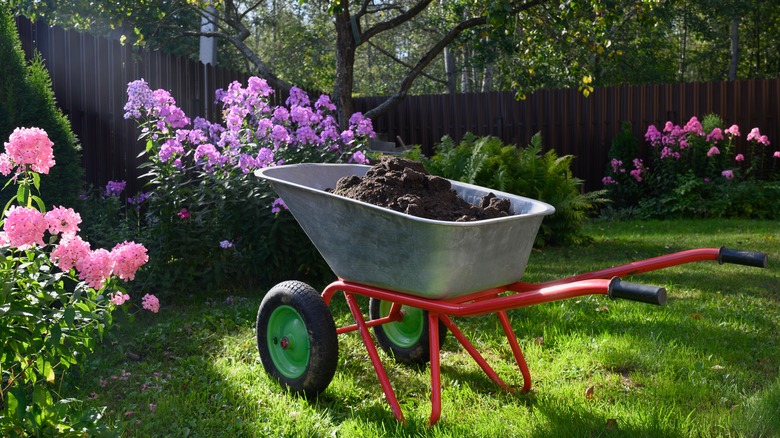
The tools you use for gardening can make your work even harder. This is especially true if these tools are unwieldy, heavy, or put an extra strain on the body. When looking for garden tools, make sure they are lightweight and have an ergonomic design. Check that the handle fits in your hand and the curves allow you to have a firm grip on the tool. Tools made of carbon steel, aluminum, and fiberglass are often lighter and don’t cause pain or stiffness when used for hours. To avoid carrying too many tools and having to switch between them, opt for tools that serve multiple purposes at once. A spade, for example, is useful for digging, transplanting, weeding, mulching, and amending the soil.
Gardening tools for seniors are geared toward accessibility and efficiency. Always select tools with long handles that give you more leverage. Some rakes are adjustable and allow you to change the length of the handle and the spread of the tines to suit your comfort and needs. If kneeling makes your knees ache or causes fatigue, consider using knee pads made of foam or a kneeling bench. As for wheelbarrows, pick one with two wheels that is easy to push on the uneven garden terrain.
Use raised garden beds
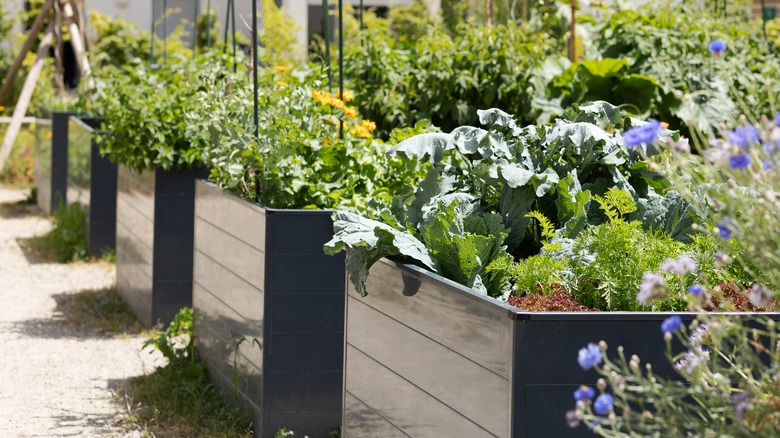
Bending and kneeling are some of the challenging aspects of gardening for elderly people. It’s not always easy to get down to the ground to tend to the plants. A raised garden bed brings the plants up to your level, increases soil drainage, and allows you to grow a wide variety of plants in one place. Raised beds vary in height from six inches to 3 feet high depending on your needs. Tall people should choose a height range between 1.5 to 2.5 feet high to avoid straining their arms or back. If you use a wheelchair or walking aids, then the recommended height of the garden bed is 2 feet high. Garden beds raised on legs give you more legroom and make gardening more comfortable.
When selecting the right height of the garden bed, make sure it’s not too high that you have to raise your arms or keep them at awkward angles while working. When it comes to plants that are perfect for a raised garden bed, you’re spoiled for choice. However, you need to pay extra attention to how you arrange them. Adding grab bars to the sides of the bed also gives you more support, making moving around more convenient.
Select the right plants
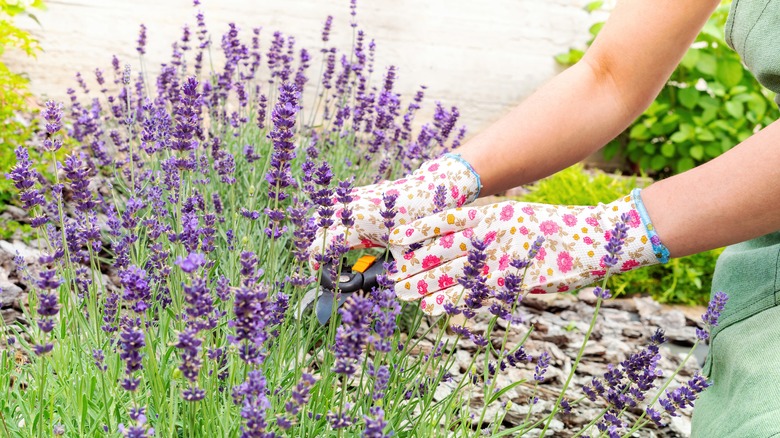
nieriss/Shutterstock
Garden plants don’t just vary in shape, size, and color, they also have different care and upkeep needs. Some plants, such as roses, are naturally high-maintenance, requiring constant work with watering, feeding, pruning, and fending off pests. Meanwhile, native plants are well adapted to the microclimate and do well on their own without the need for your constant attention. Succulents and aloes are hardy and drought-tolerance plants that are recommended for senior gardening. And when pests are a concern, pest-repellent plants such as lavenders and rosemary are an excellent choice. As for vegetables, cucumber, bush beans, lettuce, and cherry tomatoes are low-maintenance and easy to grow. If you prefer ornamentals, marigolds, sunflowers, and zinnias are some of the flowers to grow.
When selecting the right plants to grow in your senior years, safety should be your top priority. Some plants are more hazardous than others. Poisonous plants, such as rhubarb, foxglove, and lantana, should be avoided. The same goes for prickly plants with thorns on their stems, such as roses, Adam’s needle, and holly, which cause injuries when handled. Ferns and hostas are safer alternatives for thorny plants. And taking allergies into account, avoid plants that produce a lot of pollen such as juniper, chamomile, daisies, and chrysanthemums, among others.
Switch to low-maintenance ground covers
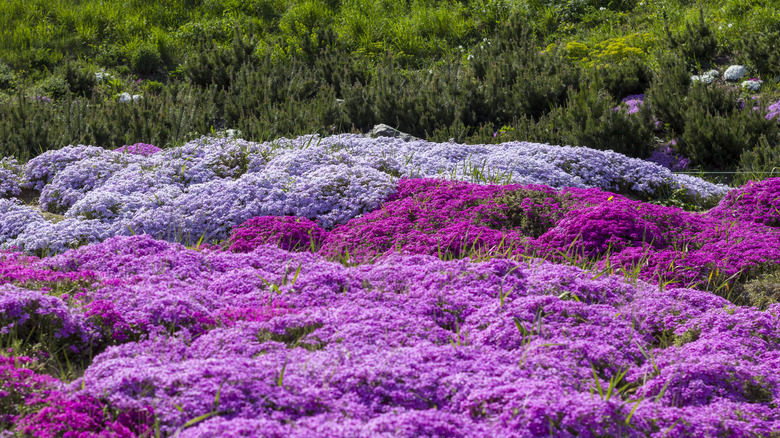
Maycal/Getty Images
As a senior person, keeping your lawn well-maintained and in good condition all year round is a tall order. Grasses grow quickly or don’t grow at all, weeds take root, and pests invade the yard, making it look worse for wear. But you can avoid all that unnecessary hassle when you replace the turfgrass in the lawn with ground covers. Ground covers are low-growing plants a few inches high that spread and cover the surface. They’re usually low-maintenance and require less watering and feeding than common grasses and hardly any mowing. There are many ground cover plants you should grow instead of grass in your yard. These include creeping phlox, carpet sedum, blue catmint, spotted dead nettle, and creeping thyme.
When looking for the right ground cover for your lawn, check with the local nursery in your area for the best plants to grow. You can either replace the whole turfgrass in the yard or only replace the parts that are hard to mow and maintain, such as slopes and shady areas. If growing ground cover isn’t an option or too much trouble, you could switch to gravel pebbles or colorful stones instead. They are ideal around raised beds and have decorative values with very little maintenance.
Invest in garden benches
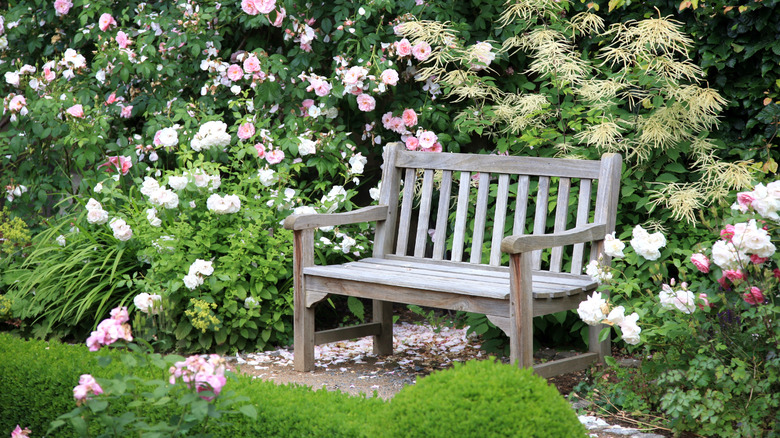
Aloha_17/Getty Images
No matter how much you love it, gardening can be demanding sometimes. And to continue to enjoy your time with the plants, you need to take frequent breaks. When you feel exhausted or need to rest, the last thing you’d want is to have to walk back into the house to find a place to sit. Adding benches and chairs to the garden is a vital way to make it a more accommodating place for older people. Placed in strategic points across the garden, they have both practical and decorative values. To make them more comfortable and suitable for quick naps, consider adding cushions.
Garden benches and chairs have to be as sturdy and stable as they are comfortable. When buying the perfect outdoor furniture, look for durability and quality to avoid injuries and mishaps. The best locations for them are around flower beds or raised beds where you’re likely to spend more time in the garden. Always place the benches under the shade of a tree or consider adding an umbrella to protect against exposure to the sun.
Consider vertical gardens
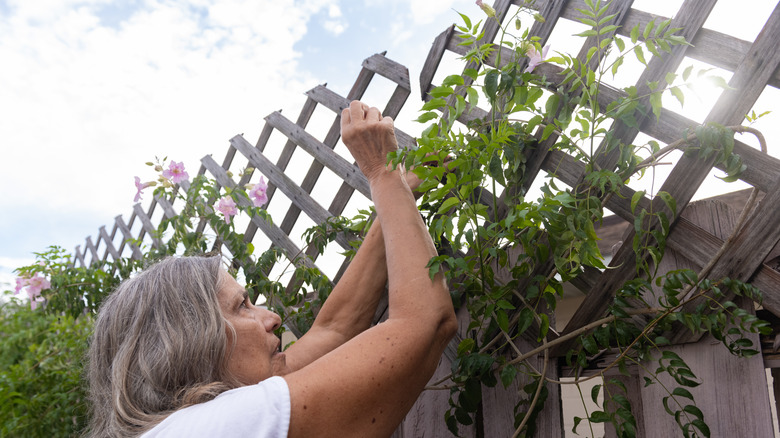
Boogich/Getty Images
One of the advantages of gardening for seniors is that you can practically practice it from any position. If bringing the plants up in raised beds is still not comfortable for some elderly gardeners, then vertical gardens are the answer. With plants growing vertically, you will take care of them while standing on your feet. You can set up your vertical garden on trellises, fences, T-posts, walls, or even the gate. Watering, pruning, cutting flowers, and harvesting fruits get a lot easier when you don’t have to bend down to reach the plants. Some of the best vines and climbing plants suitable for this upward growing include cherry tomatoes, bush beans, melons, zucchini, cucumber, squash, peas, and grapevines.
When designing vertical gardens, don’t make them too high that you can’t reach them. Adjust the T-post or trellis so that you can comfortably reach its top without overexerting yourself. Vertical gardening involves standing and walking a lot, so having a place to rest such as a bench or chair nearby should be a priority. Also, keep in mind that you would still need to do some bending and kneeling around the vertical-growing plants when fertilizing, mulching, and weeding.
Paint the tool handles with bright colors
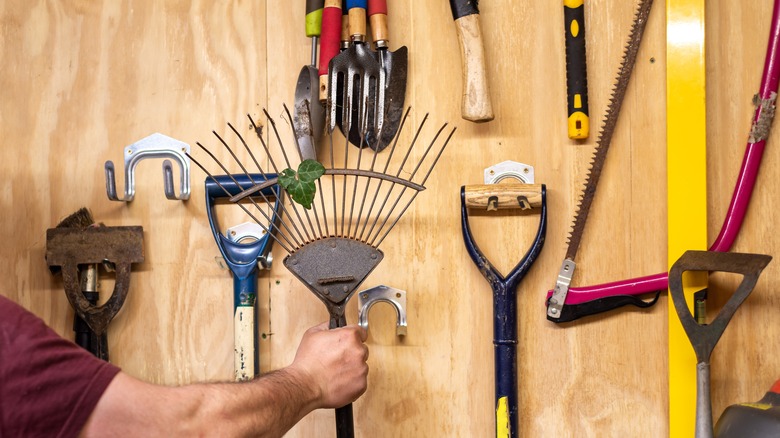
Lucy M Ryan/Shutterstock
When working with gardening tools, it’s easy to misplace them. They could get lost under the plants, get buried in the soil, or just become harder to find because of poor vision. While this can be frustrating, it’s also a hazard since the hidden tools with their sharp blades could cause injury. To minimize these risks and make the garden a safer place, consider painting the tool handles with bright colors. A little paint is the foolproof way to find your garden tools in the soil. Choosing neon-colored paint makes the handles easier to distinguish from bright-colored flowers. Before painting them, smoothen the wooden handles with sandpaper to get rid of any splinters. Then cover every part of the tool except the handle with painter’s tape. Finally, lower the handles into the paint can for a few seconds then hang them to dry.
To prevent the paint from chipping or coming off the handle with overuse, apply acrylic spray. After the paint has dried, spray the first acrylic coating. Then a couple of hours later, apply the second coating and let the tools dry overnight.
Take time to warm up and pace yourself

Evgeny Atamanenko/Shutterstock
Much like every other task or chore that requires physical strength, you need to prepare yourself every day before working in the garden. Stiff muscles are prone to cramps and injury, so taking a short walk in the morning is a good way to start the day. Walking exercises the major muscle groups in your body, including the legs, core, back, and shoulders. This will help prepare your body for the hard work ahead. Some stretching and warm-up can also go a long way in preventing sprains and injuries. When you go down to the garden, break down the work into small tasks, and switch between them every 15 minutes. Doing the same task for a long time can cause pain and muscle aches.
And above all, remember to pace yourself. The key to avoiding pushing yourself too hard is to know your limitations. Taking frequent breaks to drink water and stay hydrated will keep you from getting overheated. You also need to be wary of overexposure when working in the hot sun. Always dress in light and comfortable clothes and limit the time you spend in the garden to early mornings before 10 a.m. and early evenings after 4 p.m..
Make the garden more accessible
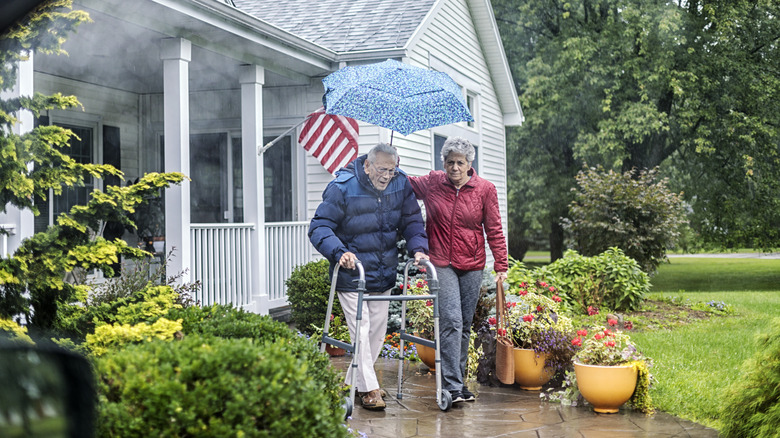
Willowpix/Getty Images
To simplify gardening and make it safer for older people, the garden itself needs to be more accessible and hazard-free. Narrow and uneven pathways lined with hedges and stone edges are not a safe place for a senior person with mobility issues. The same goes for steep steps, which cause tripping and injuries. Rethinking the layout of the garden, the paths should be at least 4 feet wide, which is enough for a wheelbarrow or a wheelchair to navigate easily. Stairs and high steps should be replaced with gentle inclines. As for the flooring, install flagstone or rubber tiles on the paths to make them level and non-slippery. Decking areas in the garden should be fortified with railings to make them stable.
Handrails along the paths make it convenient for the gardener to get support as they move around the garden. And, if poor vision is a problem, make the edgings of the paths distinct and give them a different color than the flooring. Intersections in the garden should be distinguishable with specific plants or landmarks, such as a unique bench or chair. That way seniors with memory issues will not get disoriented. In the same vein, adding locks and latches to garden gates keeps the gardener from wandering off.
Mulch more to water less
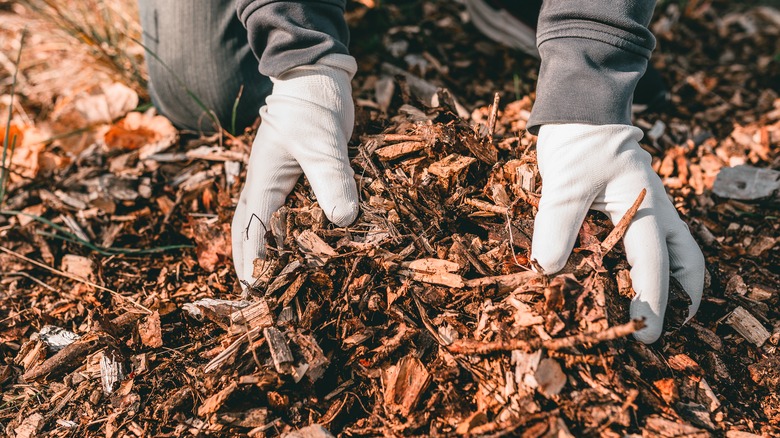
larisa Stefanjuk/Shutterstock
Mulching is a senior gardener’s best friend. It addresses some of the hard tasks of growing and caring for plants, such as regular watering, weeding, and fighting off pests. Mulch can be either organic or inorganic and once applied, you won’t have to worry about replenishing it for weeks or months. It helps retain moisture in the soil, suppresses weeds, and keeps pests at bay. Mulching should be done in the spring and again in the fall. For organic mulch, make sure the layer is between two to three to inches thick. As for inorganic mulching, a 1-inch layer is usually enough. Apply the material around annuals, perennials, bushes, and fruit trees, as well as under hedges.
Some of the organic mulches include grass clippings, wood chips, dry leaves, pine needles, straw, and shredded bark. Inorganic mulch includes rubber mulch, gravel, cardboard, and landscape plastic, among others. Organic mulching is more suitable for fall applications when it breaks down during the winter and enriches the soil with nutrients. However, where safety is a concern for a senior person, inorganic mulching might be the right option. Materials such as rubber mulch are safer to apply since they are non-slippery and can serve as a cushion, absorbing the impact of a fall.
Consider container gardening instead
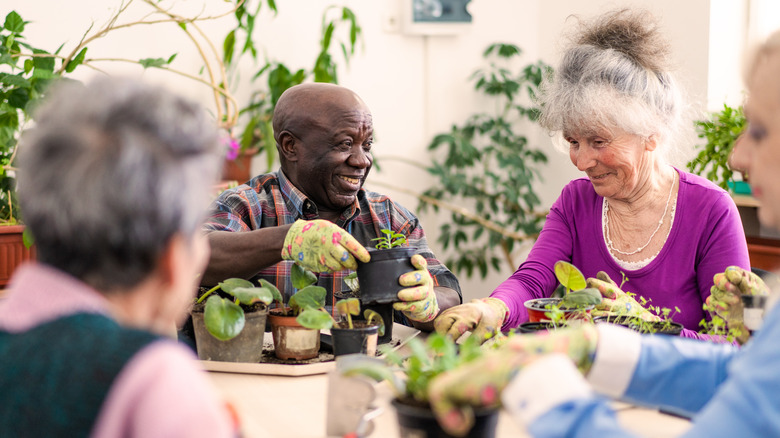
Vladimir Vladimirov/Getty Images
As you get on in years, mobility can become a problem, as well as poor vision and lack of balance. But don’t let any of these challenges hold you back. When maintaining even a small-sized garden is too difficult, then switching to container gardening is more convenient. Containers come in different sizes, from small pots to large planters. Small pots are easy to carry and move around, but they’re only suitable for plants with small and shallow root systems. Planters can accommodate a lot of plant species, but they’re heavy and hard to move. You might consider pots made of plastic since they’re more lightweight than those made of terracotta.
Container gardening is geared toward senior gardeners because of the many conveniences it provides. You can place the pots on stands with wheels for easier mobility. Meanwhile, some planters come with water tanks to automate irrigation and save you the trouble of watering the plants. When selecting the right pot for you, avoid metal containers since they can overheat in the sun and damage plant roots. Make sure the pots have drainage holes at the bottom. Covering the drainage holes with a paper towel or a coffee filter prevents the soil from washing out with the excess water and making a mess.
Install an irrigation system
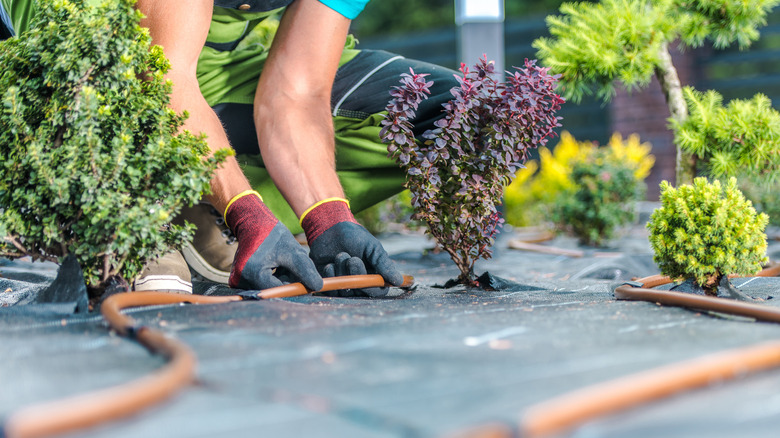
Virrage Images/Shutterstock
Regular watering is essential for many garden plants. For an elderly gardener lugging a heavy water can, it’s a struggle to keep up with the plants’ needs. A simpler option is to install an irrigation system. There are many such automated systems, including drip irrigation and smart irrigation. A drip irrigation system is equipped with a timer that releases a limited amount of water near the roots of the plant. This has the double advantage of taking the burden of watering off the hands of the gardener and conserving water usage as well. A smart irrigation system goes a step further as it collects data from the soil and the weather to adjust the timing and amount of water they provide for the plants.
Drip irrigation systems are easier to install and work well with various types of gardening, including raised beds and planters. But they are prone to malfunctioning and damage. Heavy water residue could block the emitters, while rodents and chemicals in the soil could damage the tubing. And for a senior gardener, having tubes laid on the ground can be a serious tripping hazard. As for smart irrigation systems, they’re only suitable for large gardens or lawns. Besides the upfront cost, installing these systems requires more time and work than drip irrigation.



